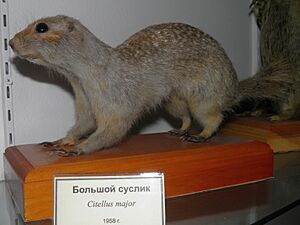Russet ground squirrel facts for kids
Quick facts for kids Russet ground squirrel |
|
|---|---|
 |
|
| Conservation status | |
| Scientific classification | |
| Genus: |
Spermophilus
|
| Species: |
major
|
| Synonyms | |
|
|
The russet ground squirrel (Spermophilus major) is a type of rodent in the squirrel family, called Sciuridae. It's also known as the hibernating large ground squirrel or the large-toothed souslik. You can find this animal in west central Asia. It naturally lives in places with temperate grasslands.
Contents
Where Russet Ground Squirrels Live
The russet ground squirrel lives in the wide, flat grasslands called steppes. These areas are found between the Volga and Irtysh rivers in Russia and North Kazakhstan. They also live west of the Volga River in the Volga Hills.
Scientists once thought they were in Xinjiang, but this was likely a mistake. It was probably a different, similar squirrel called Spermophilus brevicauda.
These squirrels are actually spreading to new areas. Roads and other human changes have created more water channels and tall grasses. This helps them move around. They can now even cross the Volga River! This is because dams have created calm, icy areas that let them travel to new places. You can find them living up to 600 meters (about 2,000 feet) high.
What Russet Ground Squirrels Look Like
The russet ground squirrel has a strong, low body. It has short legs and a tail covered in thick fur. Its back is a dark, earthy brown color. It often has lighter brown spots or stripes. The top of its head and its nose are a silvery-gray color. You might see reddish-brown patches on its cheeks and above its eyes.
The underside of its tail looks reddish, and the very tip is light-colored. These squirrels can grow up to 340 millimeters (about 13 inches) long. Their tails can be up to 105 millimeters (about 4 inches) long. An adult squirrel usually weighs around 500 grams (about 1.1 pounds).
Russet Ground Squirrel Life and Habits
Russet ground squirrels live in flat plains, mountain steppes, and semi-desert areas. They like to be near river valleys, at the edge of forests, or on the sides of ravines. You can also find them along roads, in pastures, and on land that isn't farmed.
They dig permanent homes called burrows. These burrows are about a meter (3 feet) deep. They have a straight entrance and tunnels that can be about two meters (6.5 feet) long. They also dig temporary burrows, which are not as deep. These temporary homes have slanted entrances and are simpler inside.
These squirrels are diurnal, meaning they are active during the day. Older squirrels are most busy in the mornings and evenings. Young squirrels, however, stay active for most of the day.
Hibernation and Reproduction
In winter, these squirrels go into hibernation. This long sleep lasts for about six and a half to eight and a half months. When they wake up in spring depends on the weather. It can change by up to 25 days!
Their diet includes the green parts of plants, roots, and bulbs. They also eat grass seeds, grains, and other farm crops. Russet ground squirrels have their babies in the summer. Pregnancy lasts about 23 days. A mother squirrel usually has seven or eight young at a time. The young squirrels grow very quickly. They are fully grown in about two and a half months.
The number of squirrels in a population can change a lot. Sometimes there are many squirrels, and other times there are very few. When there are fewer squirrels, you might find just one living in a burrow that used to hold a big group.
Things that can cause squirrels to die include very cold weather during hibernation. A late spring can also be dangerous. People disturbing their homes, other animals hunting them, and diseases can also affect their numbers.


